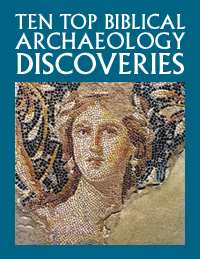This Bible History Daily feature was originally published in 2015.—Ed.

Although the famous “James, son of Joseph, brother of Jesus” inscription on an ancient ossuary (bone box) has been authenticated by two world-class paleographers, not everyone is convinced that the inscription is authentic.
The purported ossuary (bone box) of James, the brother of Jesus, is back in the news, as questions concerning its authenticity continue to plague the world-famous relic. The James Ossuary, as it’s come to be known, is a limestone bone box that bears an Aramaic inscription reading “James, son of Joseph, brother of Jesus.” Controversy—including charges of forgery—has surrounded this ossuary since the Biblical Archaeology Review first reported on the artifact in 2002. The saga of the James Ossuary culminated in 2012 with the acquittal of Israeli antiquities collector (and owner of the ossuary) Oded Golan in a seven-year “forgery trial of the century,” but the story isn’t over yet. In “Predilections—Is the ‘Brother of Jesus’ Inscription a Forgery?” in the September/October 2015 issue of BAR, Hershel Shanks reviews the latest argument against the authenticity of the inscription.
The antiquity of the 20-inch-long James Ossuary itself is not questioned—it dates between the first century B.C.E. and 70 C.E., a period when the practice of ossilegium (the collection of the bones of a deceased person) was prevalent among the Jewish population. It is the inscription on the James Ossuary—a mere 20 letters written in Aramaic—that has incited years of debate. If real, the inscription would be the earliest written reference to Jesus. Because the ossuary was purchased with an unknown provenance from an antiquities dealer, the authenticity of the “brother of Jesus” inscription needed to be verified by experts.


The Aramaic inscription on the so-called James Ossuary reads “James, son of Joseph, brother of Jesus.” Drawing by Ada Yardeni.
The inscription, reading “James, son of Joseph, brother of Jesus” has been authenticated by two eminent paleographers (specialists in dating, interpreting and authenticating inscriptions): André Lemaire of the Sorbonne and Ada Yardeni of the Hebrew University of Jerusalem. In 2003, however, the Israel Antiquities Authority (IAA) appointed a committee of scholars to study the “brother of Jesus” inscription and report its findings. The committee concluded that the inscription was a forgery.
According to Dutch scholar Pieter van der Horst, who published an analysis of the IAA committee’s report in his new book,1 the IAA “appointed almost exclusively committee members who had already expressed outspoken opinions to the effect that the inscription was a forgery.” Van der Horst observes that the committee members didn’t abide by the IAA guideline “to arrive at the truth based on pure research only—without taking into account any other related factors regarding the collector, current gossip, rumors or prejudices,” nor did they follow the directive that each scholar “should work in his own discipline.”
The “forgery trial of the century” charging five people of running a massive forgery ring lasted seven years and included 138 witnesses, more than 400 exhibits and over 12,000 pages of testimony. Three paleographers were called to testify: André Lemaire, Ada Yardeni and Christopher Rollston, now of the George Washington University. When Rollston took the stand, he refused to give an opinion on the authenticity of the “brother of Jesus” inscription because he did not specialize in Second Temple inscriptions (the time of the ossuary).
“I only talk about what I am sure of,” Rollston said in court. “That is not my field.”
The trial concluded with the acquittal of antiquities dealer and James Ossuary owner Oded Golan and the other defendants on all charges of forgery (though Golan was convicted of minor charges, including trading in antiquities without a license).
“I thought that this was the end of the matter until the Easter season in 2015, when I watched an hour-long TV program on CNN regarding the ossuary and its ‘brother of Jesus’ inscription,” writes Shanks in his BAR article. “Only one scholar addressed the question of the authenticity of the inscription—the same Christopher Rollston who could not express an opinion at the trial. Now he was prepared to opine on the authenticity of the inscription—for all of 33 seconds.”
What is Rollston’s reasoning for why the “brother of Jesus” inscription is a forgery? Is his judgment based on his predilection against unprovenanced inscriptions, as Shanks suggests? Learn more by reading the full article “Predilections—Is the ‘Brother of Jesus’ Inscription a Forgery?” by Hershel Shanks in the September/October 2015 issue of BAR.
Not a BAS Library member yet? Join the BAS Library today.
This Bible History Daily feature was originally published on August 31, 2015.
For more on the “forgery trial of the century,” visit the BAS Library to see a collection of BAR articles highlighting the various scholarly and scientific arguments that have been made both for and against the authenticity of the James Ossuary, the Yehoash tablet and other ancient artifacts.
Notes:
1. Pieter W. van der Horst, Saxa Judaica Loquuntur: Lessons from Early Jewish Inscriptions, Biblical Interpretation Series 134 (Leiden: Brill, 2015), pp. 67–87.
The post Is the “Brother of Jesus” Inscription on the James Ossuary a Forgery? appeared first on Biblical Archaeology Society.

0 Commentaires